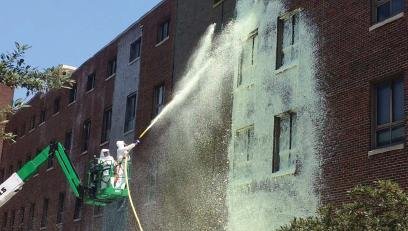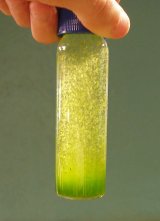EPA Research in Ohio

EPA researchers are working hard to protect communities across the nation. Learn about some of the work EPA researchers are doing in Ohio.
- Emergency Response
- Drinking Water
- Stormwater and Wastewater Research
- HABs and Nutrients
- Land Research
- Health Research
For more EPA work, see EPA in Ohio.
Cleanup Following a Radiological Incident

At Batelle in Columbus, EPA researchers in the Office of Research and Development (ORD) worked with colleagues at the Department of Homeland Security and the Department of Energy for the Wide Area Urban Radiological Containment, Mitigation, and Clean up Technology Demonstration. This highly successful event provided first responders with options for response to a wide area radiological incident, such as a dirty bomb explosion or a nuclear accident, by showing the responders the operation feasibility of the tools in real time while the end users deployed the technologies.
Developing Materials to Help Community Members Use and Maintain Water Filters
To understand what support is needed for effective water filter use and to improve educational materials, EPA risk communication staff, scientists, and engineers partnered with the Lab at the Office of Personnel Management (OPM) and The Junction Coalition, a community organization in Toledo. This collaboration aimed to address knowledge gaps and provide comprehensive resources to help community members properly use and maintain water filters.
Showcasing Research Capabilities to Local and National Media
Some of the world’s leading water researchers work at EPA’s water research labs in Cincinnati, Ohio. EPA recently hosted members of local and national media on a tour of the unique research complex, where they discussed several topics including PFAS in drinking water, lead service lines, and legionella in premise plumbing. Read EPA Researchers Showcase Research Capabilities to Local and National Media.
Real-Time Water Distribution System Analysis
EPA's tool EPANET-RTX gives water utilities the necessary tools to enhance system operations including emergency response and improved operations, e.g., better pressure management, leak detection and water quality. EPANET-RTX has been tested or demonstrated in several locations including Ohio, Colorado, Florida, Kentucky, and Michigan.
Advancing the Potential for Stormwater Reuse
Managing stormwater runoff is a complex environmental challenge for communities across the country. One potential option? Reuse. EPA researchers collaborated with partners on a project to evaluate samples from stormwater collection systems that could potentially be harvested for landscaping and agricultural irrigation near Chicago, Cincinnati, Cleveland, and Minneapolis. Read Advancing the Potential for Stormwater Reuse: Investigation of Water Quality and Treatment.
Partnering with Cincinnati’s Cooper Creek Collaborative to Improve Water Quality
Impervious surfaces, like most buildings and pavement, can’t absorb rain water as well as forests and other natural environments. This can create water quality issues for many urban areas due to stormwater runoff. To help with this issue, EPA researchers in Cincinnati, Ohio are partnering with local organizations and other federal agencies to retrofit urban stormwater infrastructure networks with technology to improve water quality and moderate flows in the Cooper Creek Watershed. Read the article EPA Researchers Partner with Cincinnati’s Cooper Creek Collaborative to Improve Water Quality.
Helping Community Drinking Water Systems Find Cost-Effective Solutions to Treatment Challenges
Emerging contaminants, such as per- and polyfluoroalkyl substances (PFAS), are challenging to drinking water systems across the country. Effective treatment for emerging contaminants can be unknown, difficult, and extremely costly. Working with the state of Ohio, EPA researchers are providing technical assistance to one small and two large community water systems with PFAS concerns to help them identify optimal, cost-effective treatment methods and optimize the long-term operation of their chosen technology. These efforts will also be used to develop best practices and performance and cost estimate tools so water utilities across the country can make informed treatment and operational choices. Read Technical Assistance for Treatment Options to Remove Emerging Contaminants.
Managing Excessive Nutrient Runoff into East Fork Lake
Excessive nutrient runoff in East Fork Lake in southwestern Ohio causes harmful algal blooms (HABs). This multiagency cooperative, led by ORD staff, leverages resources to help demonstrate how to better protect water quality in the watershed. ORD provides technical support, guidance and expert review, runs watershed simulation models, assists in monitoring water quality, participates in statewide HAB modeling efforts with USGS, and supports the state of Ohio on nutrient Total Maximum Daily Load implementation in the East Fork.
Analyzing Cyanobacteria in Lake Erie

Lake Erie is a drinking water source for numerous communities. Cyanobacterial HABs have been increasing in severity and toxin production on the lake over the past five years. In September of 2013, the Ohio EPA placed a community under a "Do Not Drink” advisory due to the breakthrough of toxins into the finished public drinking water. Many of the treatment facilities on the lake were built before World War II and were designed for particulate removal. As a result, toxin removal at these facilities is difficult and expensive. Recognizing the potential health and economic consequences, EPA researchers, in partnership with Ohio EPA and the U.S. Geological Survey, conducted studies aimed at helping treatment facilities cope with this water quality change in their surface water source and finished waters. Learn more about drinking water treatment research for HABs

Preventing Algal Blooms with a “Pinch of Sugar”
EPA researchers are looking at ways to inhibit the development of algae that can produce cyanobacterial HABs. One method they are studying is adding a food source to water that would allow other bacteria to better compete with the cyanobacteria and prevent or reduce the development of these harmful algal blooms. The researchers collected weekly water samples from an Ohio lake during the 2021 bloom season. Read Preventing Algal Blooms with a “Pinch of Sugar”.
An Application for Risk Characterization of HABs on the Ohio River
In 2015, an unprecedented algal bloom in the Ohio River caught many communities by surprise. Since then, EPA researchers have been working with water quality managers to address a gap in scientific research regarding the ability to predict harmful algal blooms on rivers. Read A Better Way: An Application for Risk Characterization of HABs on the Ohio River.
Remediation and Restoration of Great Lakes Areas of Concern (AOCs)
Ohio EPA is implementing several projects under the Great Lakes Restoration Initiative, designed to protect and restore the chemical, physical and biological integrity of the Great Lakes Basin ecosystem. ORD provided technical and sampling support from site and baseline characterization, remedy and restoration effectiveness studies, and report writing.
Elevated Temperatures at a Municipal Landfill
ORD provided advisory assistance to Ohio EPA regarding an elevated temperature landfill where the management company proposed to continue and expand operations in previously capped areas that had reverted to normal temperatures. The conditions caused by elevated temperatures require corrective actions very different than those of a typical fire, and state regulators may not be fully aware. ORD supports landfill operators, EPA regions, and state agencies to provide expertise and assistance in both diagnosing the conditions and identifying proper management techniques that mitigate nuisance odors to the landfills’ neighbors.
Renovated Housing Linked to Decrease in Childhood Asthma Rate in Cincinnati Neighborhood
Certain conditions in a home can impact the health of the people living there. To help protect children’s health, EPA scientists are looking at how housing conditions affect childhood asthma. Read about how renovated housing was linked to a decrease in childhood asthma rates in a Cincinnati neighborhood. Read Renovated Housing Linked to Decrease in Childhood Asthma Rate in Cincinnati Neighborhood.
Understanding Community Infection Rate of COVID-19
Early in the pandemic, researchers at EPA’s laboratory in Cincinnati began looking for evidence of SARS-CoV-2 in municipal wastewater. Wastewater monitoring can help health officials know which communities need more access to testing or predict when infection waves might be present in a community, often before anyone shows symptoms of the disease. EPA researchers partnered with the Ohio Water Resources Center, Ohio EPA, and Ohio Department of Health on a state-level wastewater monitoring study to track community infection rates for the presence of SARS-CoV-2 (the virus that causes COVID-19).
